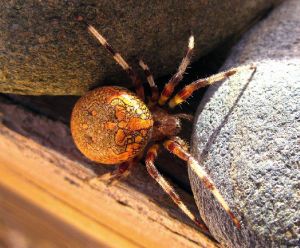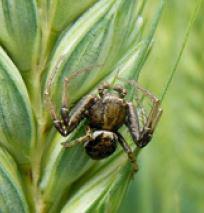Spider

The family includes different genera :
- Mainly in vineyards and arboriculture : Salticidae, Miturgidae, Araneidae
- Mainly field crops and vegetables : Lycosidae, Linyphiidae
Generally annual life cycle

Habitat : Woods, meadows, verges
Usual method of eliminating pests
- Polyphagousinsect with general predation (including other beneficials)
- One web can capture up to 1,000 winged aphids.
- Insufficiently known but abundant, quick to hunt and effective at capturing. Plays a significant role in natural population control
- On soil pests (arthropods, subterranean bioaggressors ) and aerial pests.
- Preferred prey : aphids, psyllids, leafrollers, leafhoppers, thrips, diptera.
- Genus Padosa hunts for meligèthes and leafrollers.
Technical and agronomic management advice to encourage them
Favourable factors :
- Meadows and patches of woodland
- Diverse landscapes
- Unmown areas to keep eggs safe
Unfavourable factors :
- Phytosanitary products
- Tillage (deep and/or shallow)
Observation methods
Barber trap - Observation of webs in the field
Appendices
Sources
- To find out more about pest control in orchards by spiders : https://www.produire-bio.fr/articles-pratiques/araignees-vergers-de-pommiers-regulent-ravageurs/
- Agrifind https://www.agrifind.fr/alertes/auxiliaires-de-culture/auxiliaires-araignees
- Geco https://geco.ecophytopic.fr/geco/Concept/Araignee
This article was written in partnership with <a href="https://www.agrifind.fr/alertes/auxiliaires-de-culture/auxiliaires-araignees">Agrifind</a> and <a href="https://www.terresinovia.fr/">Terres Inovia</a>.

